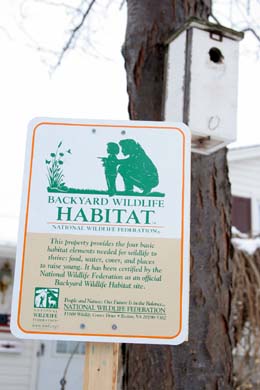
Even with all three children grown up and out of the house, Paul and Laurie Reisinger of Spencerport refuse to become empty nesters. The couple has gone to great lengths to keep all the nests in their yard full, along with the trees, bushes, pond and feeding tables. In recognition of the work the couple has done to benefit nature, the National Wildlife Federation recently certified their yard as a Wildlife Habitat. The Reisingers outreach began 25 years ago when Laurie purchased her first birdfeeder. She became interested in the birds that the feeder was attracting and that interest started her research. She began reading about many different types of birds and the styles of shelter and food that they prefer. Laurie found that different types of feeders would attract different styles of birds. And so began a backyard renovation that included adding more feeders, nesting boxes, feeding tables, specialty shrubs and a heated pond. Their home on Brittain Circle backs up to a wooded lot and before long the Reisingers became acquainted with everything that had been living in those woods. In addition to several different species of birds including hummingbirds, blue birds, sparrow hawks, woodpeckers, owls, turkeys and ducks; the Reisingers were joined by deer, fox, possum, squirrels and coyotes. "We were amazed at what was coming out of the woods," Laurie said. The response they were receiving served to encourage Laurie to study more and find new ways to attract different birds. In the summer months the Reisingers put out about 100 lbs. of seed each week. They also put out oranges to attract orioles and blocks of suet for woodpeckers. Laurie is the mastermind behind planning what they will do next, but Paul plays an important role as well. "He does all my grunt work for me," Laurie said. Due to the number of visitors they are nourishing, there is a significant amount of labor involved. With the help of one of their sons, Laurie has started a Web site where she displays pictures of her backyard (www.laurasbackyard.com). Even in the colder months their backyard habitat keeps them busy. "It gives us something to do in the winter," said Paul. "You'd be surprised how many birds stay around." And the Reisingers have an interesting way to know when the seasons are changing. "We always know that it is spring when the ducks land in our pool," Laurie said. The couple's love for wildlife hasn't been lost on their children. Now, with the recent birth of their grandson, Wesley, they hope to pass it on to yet another generation. They will be getting the two-and-a-half-month old started with his own bird feeder for Easter. Developing a backyard habitat
|


